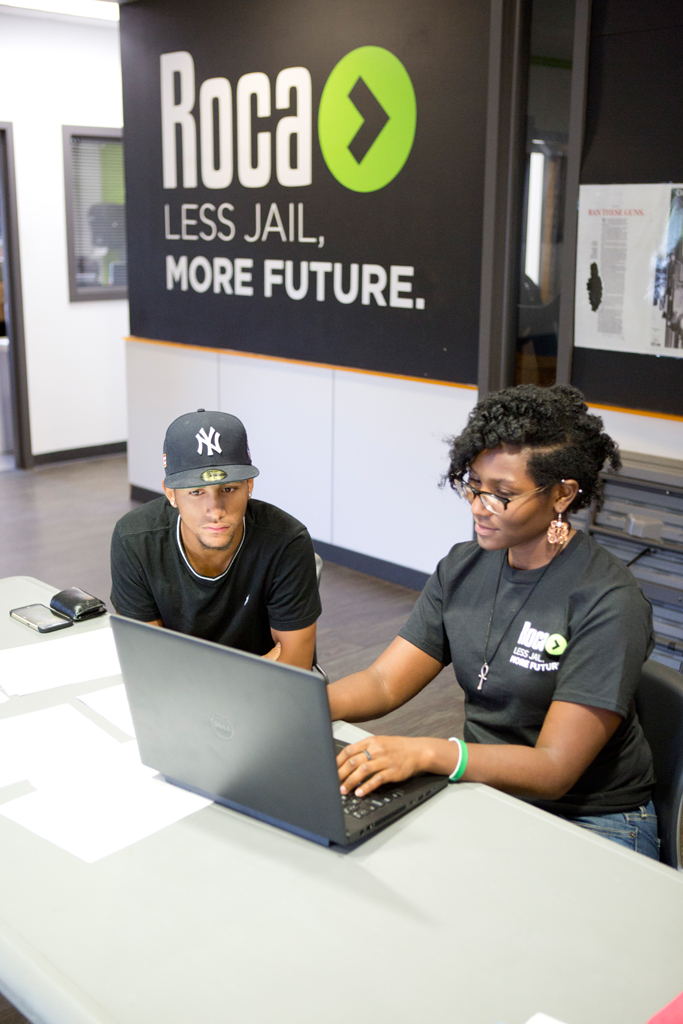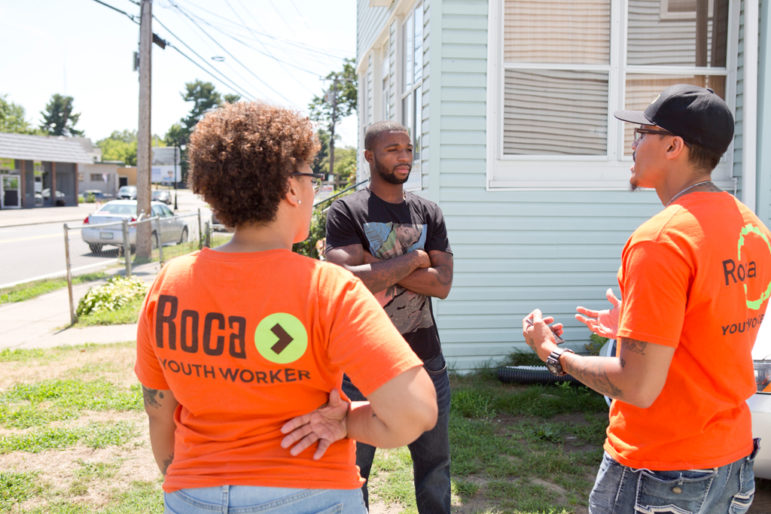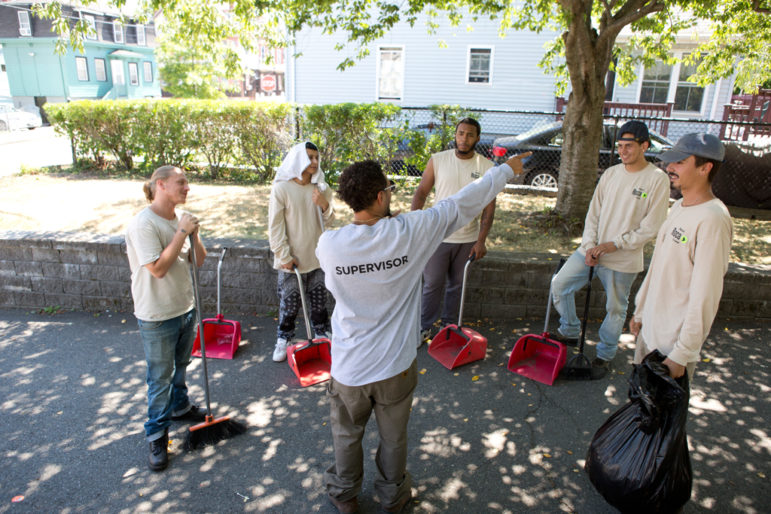
Photos by John Soares/Roca
All of Roca’s programming is tailored for high-risk young people who are not yet ready, willing or able to participate in group programs. High school education classes, workforce readiness and cognitive behavioral skills are taught in one-on-one classes and in small groups.
WASHINGTON — For more than a decade, juvenile justice reformers have used developments in adolescent brain science and psychology to make their case for a system that emphasizes rehabilitation and second chances for young offenders.
Those same developments now are helping fuel an interest in how the criminal justice system treats young adults. This population has plenty in common with their younger counterparts because they, too, are still maturing, researchers and policymakers say.
And, because young adults ages 18 to 24 are disproportionately likely to commit crimes and to reoffend, they’re a prime target in the quest to reduce mass incarceration, they add.
“We don’t want crime. We don’t want victims. Our goal is to protect society. So, where do we look next?” said Lael Chester, a research fellow in the Program in Criminal Justice Policy and Management at Harvard’s Kennedy School, which has promoted the idea that young adults are a population worth paying attention to.
Jurisdictions across the country have recently began rolling out experiments related to young adults, with more action expected this year and beyond:
- A community court in Cook County, Illinois, will focus on young adults ages 18 to 26, using restorative justice techniques that emphasize healing relationships between victims and offenders;
- Five counties in California will have the flexibility to allow some young adult offenders ages 18 to 21 to serve their time in juvenile correctional facilities.
- The federal government has provided $31 million in grants to organizations that can design programs to help young adults re-enter the community after serving their time in prison; and
- Lawmakers in Connecticut are expected to debate once more this spring whether to raise the age of juvenile jurisdiction, so that youth remain in the juvenile system until age 21 rather than age 18. Gov. Dannel P. Malloy, a Democrat, has championed the headline-grabbing proposal.
“If we get it right with this age group, if we intervene and significantly change their behavior for the better, we can use this as a way to improve public safety,” said Brent Cohen, senior advisor to the assistant attorney general in the Office of Justice Programs at the Justice Department.
As reformers consider if and how to change the justice system for young adults, they will have to grapple with plenty of hard questions, including how to tailor services to the needs of young adults and how to explain to elected officials and the public the need for a new focus.
Marc Schindler, executive director of the Justice Policy Institute, said the juvenile justice field likely will have plenty of advice to offer about how to take a developmentally appropriate approach to reform.
“I would hope those who are leaders in the juvenile justice field see themselves as resources to share their knowledge and their experiences of what’s worked and what hasn’t worked,” he said.

Roca’s youth workers reach out dozens of times to high-risk young people over weeks and months, and keep coming back until they build trust and are able engage in harder conversations and push behavior change.
Crafting appropriate responses
Discussions about tackling the young adult population draw on the fields of adolescent brain science and psychology. Scientists have shown teenagers have less control of their emotions and are more willing to take risks, findings that have propelled the idea that “kids are different” when it comes to their culpability for crime and potential for rehabilitation.
“Adolescents just aren’t as good as adults at putting on the brake,” said Elizabeth Cauffman, a professor of psychology and social behavior at the University of California-Irvine.
However, as researchers have charted for the past two decades the way adolescents develop, they also realized there’s no that separates a teenager from an adult, arguing that development continues into a person’s mid-20s.
“You can’t with a straight face say that 18-year-olds are adults and 17-year-olds are not. You just can’t,” said Lisa Jacobs, program manager at the Center for Criminal Justice Research, Policy and Practice at Loyola University in Chicago, which has a young adult research initiative.
But the fact that maturation is a process means a 15-year-old is not identical to a 20-year-old, not when it comes to their exact developmental stage, and not when it comes to the programs they need to thrive in society after criminal justice involvement.
“What a 21-year-old needs and what a 16-year-old needs and what a 10-year-old needs are not the same,” Cauffman said.
For example, the education, housing and social needs — the very things policymakers will have to consider when they craft programs — could all differ for young adults compared with their younger counterparts.
When Connecticut first mulled raising the age to 21, a group of prominent adolescent researchers warned that the science wasn’t settled on whether young adults’ brains were so immature that they deserved the same treatment as teenagers.
Jacobs said that’s a fair point — that there are thorny questions about how to make programs work for young adults, especially if reformers use a juvenile justice framework as their starting point. But that’s not a reason to abandon the effort before it even begins, she said.
“You don’t have to use the same system, you don’t have to use the same program, but there are things we can learn,” she said.
Mike Lawlor, undersecretary for criminal justice policy and planning in Connecticut, said a common worry he heard when the legislature considered raising the age to 21 was that young adults didn’t belong in the same facilities as much younger teenagers.
He’s replied that the proposal isn’t intended to suggest that 20 years old is the same as 16 years old, or that young adults and teenagers should live in the same spaces while detained. The motivation instead is that the rehabilitative, community-based and developmentally informed approaches that have guided reforms for juveniles are worth looking at for older offenders.
“That mechanism is what we’re trying to take advantage of,” he said.
Schindler, at JPI, said researchers heard a similar idea last year when the think tank held stakeholder roundtables on potential young adult reforms with leaders from law enforcement, juvenile and adult corrections, the courts and community-based organizations, researchers and formerly incarcerated young people. No one suggested the juvenile system was perfect but they thought it could be a starting point.
And for the most part, the roundtable participants did not support creating a third system just for young adults but instead applying what works in juvenile justice to young adults in the criminal justice system, with a focus on community-based programs.
In their final report on the roundtables, JPI wrote that the field also should be aware of the potential pitfalls of using brain science research to guide reforms for young adults.
“This conversation should not lead to the limitation of other legal rights, such as voting, or influence policies in other areas, like family planning,” the report said.
JPI also noted that the arguments rooted in adolescent brain development have been successfully contested in lower courts, which could limit their use in criminal justice reform.

Roca participants and their crew supervisor clean the streets of Chelsea, Massachusetts, as part of Roca’s contract with the city. The young men are in a transitional employment program, where they gain real wages for real work while learning critical job skills.
What’s next?
Emily Morgan, a senior policy analyst at the Council of State Governments Justice Center, also has been watching as states tinker with supervision and services for young adults, including in a report that outlines opportunities and difficulties jurisdictions could encounter.
She expects states will begin their efforts with low-risk, nonviolent offenders before bringing in a larger group of offenders.
Regardless of the approach though, Morgan said it’s critical to remember there’s little research on what interventions will work best with young adults. Policymakers should build in ways to track their results if they want to build a knowledge basis that goes beyond one-off projects.
“As states are pioneers in the effort everyone is going to look to them, so it’s important they know how they measure success,” she said.
States also can look to a few models of long-standing programs that may offer clues about how to provide support to young adults.
In a 2016 national scan, the National Institute of Justice identified programs across the country that focus on justice-involved young adults, including young adult courts, probation and parole programs, district attorney-led programs, community-based partnerships, prison-based programs, and advocacy and research programs.
Among the programs researchers were most frequently referred to was Roca, a community-based program in Massachusetts that has worked with young adult offenders for decades.
Roca uses an intensive model focused on young adults who leave prison and are at high risk for reoffending. For months, caseworkers will contact potential participants, stopping by their homes and calling them over and over until they can establish trust and begin to help someone rebuild their lives.
Anyone hoping to work with young adults should recognize that it isn’t an easy job, said Yotam Zeira, a spokesman for the group.
“You have to build the capacity, the culture and recognize that it’s hard. You have to provide training and support for staff to keep up with it,” he said.
But Zeira is encouraged by the conversations he hears happening about young adults.
“The world is kind of catching up,” he said.